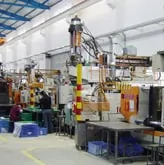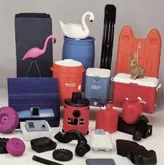(click on thumbnail to enlarge)


Lerner Molded Plastics has provided industry-leading custom blow molding services to customers across the United States for over 25 years. This extensive plastic manufacturing experience, combined with our advanced blow molding equipment, enables us to produce high-quality custom blow molded components from a wide range of plastics at a competitive price.
Blow molding is a manufacturing process that involves turning plastic material into a hollow plastic component. The first step is melting and extruding plastic pellets into a tube (i.e., parison). The tube is then enclosed within a pre-formed mold. Next, air is blown into the contained tube to force the material to conform to the shape of the mold. Finally, the material is allowed to cool and harden so it maintains the hollow form. The process can be used to manufacture parts and products in various shapes and sizes.
Blow Molding Capabilities at Lerner Molded Plastics
Our plastic manufacturing facility houses single-head and dual-head blow molding units and shuttle press systems. This equipment allows us to accommodate up to 40-pound head capacity and high-volume production needs. We can produce small to large parts with varying intricacies and number of cavities in prototype to full production quantities.
Our material capabilities include:
- ABS. ABS is hard but not as chemically resistant as PE or PP. It is commonly used to create blow molded housings and small appliances.
- Acetal. Acetal is hard, lightweight, and durable. It is generally used in granule form for blow molding operations.
- Acrylic. Acrylic can be difficult to work with in blow molding operations. Its low cost and clarity make it a popular option for the manufacture of optical parts and products.
- High-density polyethylene (HDPE). HDPE offers excellent chemical and impact resistance and good cold temperature properties. However, it is not as dimensionally stable as other materials.
- Nylon. While nylon is generally used for injection molding operations, certain variants are used in blow molding operations. Examples include nylon 6, nylon 4-6, nylon 6-6, and nylon 11. The material offers good chemical and thermal resistance.
- Polycarbonate. Polycarbonate demonstrates very good impact strength and temperature resistance. Additionally, it is exceptionally clear, making it ideal for optical components.
- Polyester (PET/PETG). PET/PETG is clear, forms well, and has excellent impact strength.
- Polypropylene (PP).PP exhibits excelling chemical resistance, very good rigidity and impact strength, and good thermal resistance. However, similar to HDPE, it is not as dimensionally stable as other materials.
- Polystyrene (PS). Similar to acrylic, PS is difficult to extrude during blow molding operations as it is highly susceptible to melting into a liquid state. However, its clarity makes it well-suited for use in optical components if it is handled carefully and properly.
In addition to our blow molding capabilities, we offer a broad selection of secondary services, including in-line and post-molding assembly, ultrasonic welding, and part decoration. We also provide complete supply chain services, such as sourcing, warehousing, inventory control, Kanban, logistical support, and packaging.
Advantages of Custom Blow Molding
Compared to other plastic manufacturing processes, blow molding has many advantages, including:
- Suitability for automation. The blow molding process readily accommodates automation, allowing manufacturers to create accurate components in higher volumes at faster speeds.
- Cost-effectiveness. The blow molding process requires less pressure than other manufacturing methods, which helps reduces production costs. Additionally, the inherent recyclability of the base material and faster cycles of the process result in lower material utilization and shorter production times, which translates to overall decreased production costs.
- Capacity for mass production. Manufacturers can produce hundreds or thousands of blow molded units within a short period. This quality makes the process relatively inexpensive compared to other molding methods, making it more customizable and scalable.
- Manufacturing flexibility. Blow molding can be used to produce a variety of hollow components in prototype to production volumes depending on the needs of the customer.
Who Uses Custom Blow Molding?
Custom blow molded components find application in a wide range of industries, including, but not limited to, the following:
- Automotive
- Consumer Goods
- Housewares
- Medical
- OEM
- Toys
The blow molding experts at Lerner Molded Plastics regularly produce parts and products for housewares and toys to automobiles and furniture.
Lerner Molded Plastics: Your Blow Molding Expert and Partner
If you’re looking for a custom blow molding partner, turn to the experts at Lerner Molded Plastics. We are a top custom blow molding company with extensive experience producing plastic parts and products for customers across various industries. To learn more about our blow molding capabilities or discuss your project requirements, contact us or request a quote today.
Portfolio
Precision Blow Molding Capabilities
| General Custom Blow Molding Capabilities | Custom | ||
| Product Capabilities |
|
||
| Mold Process Type | Blow | ||
| Material |
|
||
| Colors | Custom | ||
| Equipment Capabilities |
|
||
| Head Capacity | Up to 40 lb. | ||
| Secondary Services | In-Line or Post Molded Secondary Assembly Ultrasonic Welding Part Decorating (Hot Stamping, Pad Printing, Painting) Bar Coding and Labeling Complete Packout Services Warehousing Services and Drop Ship Capability All Material, Packaging, and Components Sourcing Complete Supply Chain Services Product Distribution Logistics Engineering Product Development Mold Making Tooling Vendor Managed Inventory Programs Kanban |
||
| Production Volume | Prototype Runs to Full Production Capacity |
Additional Information
| Industry Focus |
|
||
| Intended Application |
|
||
| Industry Standards | ISO Certified | ||
| File Formats | SolidWorks Pro-Engineer |


